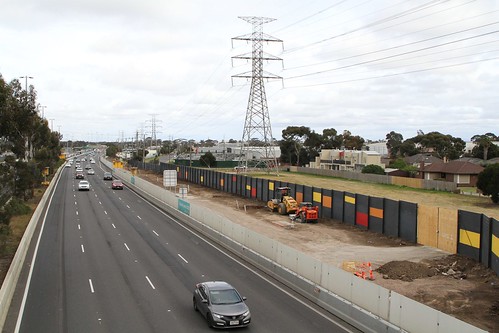The tunnel boring machines responsible for digging Melbourne’s Metro Tunnel started work in August 2019, but the concrete segments that will line the new tunnel have had a much longer journey.
Their start their life behind an anonymous gate in Ravenhall, next door to the Regional Rail Link tracks.
But the ‘tunnel lining segment manufacturing facility’ sign gives it away.
Overhead cranes travel over the casting yard.
Segments and a sunset. 🌅 More than 1,500 concrete segments have been manufactured at our tunnel lining segment facility in Melbourne’s west. Our tunnel boring machines will use 56,000 curved concrete segments to create a watertight lining inside the twin 9km rail tunnels. pic.twitter.com/rCi0iIzOCp
— Metro Tunnel (@metrotunnelvic) July 22, 2019
Production started early, so that a stockpile of tunnel lining segments could be built up.
🌾 It’s no cornfield, but how’s the serenity? So much serenity. 🌾
Our tunnel segment manufacturing facility is in full production mode pumping out the 56,000 concrete segments required to line the Metro Tunnel’s twin nine-kilometre tunnels. pic.twitter.com/ZD1tva9YQ2
— Metro Tunnel (@metrotunnelvic) August 20, 2019
180 segments being poured a day.
The first segments were delivered in August 2019.
The first tunnel segments have arrived at the new North Melbourne Station site with 18 concrete segments delivered, each weighing 4.5 tonnes.
The TBM will use these segments to create temporary rings to line the steel bell, which is an innovative launching method for the TBMs. pic.twitter.com/QzOUQZxx4P
— Metro Tunnel (@metrotunnelvic) August 22, 2019
Driven across Melbourne six at a time on the back of a semi-trailer.
Until they arrived at the future North Melbourne station site.
In September work on the shed over the station box was still underway.
But was completed in October.
Ready to store the concrete segments, before they are lowered into the tunnel.
Loaded onto a rubber tyred TBM support vehicle.
Even the mightiest machines need some support 🚚
Meet our TBM support vehicles, tasked with delivering the concrete segments needed to line the Metro Tunnel and will eventually be used to transport our team to and from the TBMs. pic.twitter.com/5Nu2CiaYSE
— Metro Tunnel (@metrotunnelvic) November 13, 2019
And driven through the tunnel to the TBM itself.
TBM Joan is on her way towards Kensington, installing a number of tunnel lining rings, composed of concrete segments. The team has been monitoring Joan’s performance and systems, including confinement pressure management, ring building, segment handling and grouting. pic.twitter.com/Hsa9dVdZ2f
— Metro Tunnel (@metrotunnelvic) October 6, 2019
Which then assembles them into a tunnel wall.
A sidenote on the gantry cranes
The gantry cranes at the casting yard were supplied by Australian manufacturer Eilbeck Cranes, as were cranes at the Melbourne CBD worksites.
Those cranes seem to be more successful than those at Parkville station – dismantled due to safety concerns.
Meanwhile on the West Gate Tunnel
The West Gate ‘Tunnel’ might be predominately surface roads, but it actually features two tunnels: 4 kilometre long outbound and 2.8 kilometre long inbound.
The precast concrete segments for this project are being manufactured by LS Precast in Benalla, served by a dedicated rail siding.
https://www.youtube.com/watch?v=5pEzo0HCfBY











That’s the second story about tunnel lining segments that I have seen this week.
Geoff Marshall’s latest video on youtube is about tunnel lining segments.
They’re using a narrow gauge railway inside a sewer tunnel to deliver materials.
[…] concrete segments for the Metro Tunnel were cast at a yard at Ravenhall, only 30 kilometres from their final […]